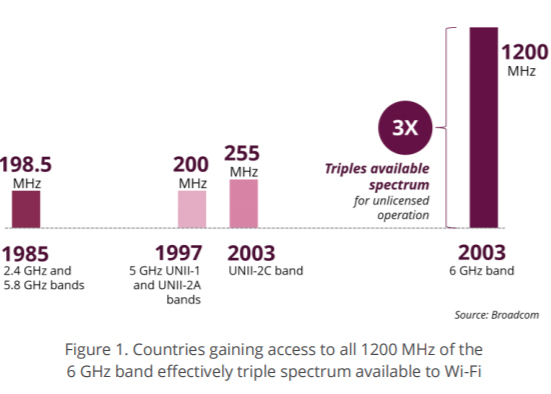
By John Bugailiskis
ONE REALLY ENJOYABLE PART of the digital version of CES 2021 was not having to do battle with the other 170,000 attendees for a decent Wi-Fi signal in Las Vegas.
So, it was thrilling then to see a report just released by the Wi-Fi Alliance which claims “countries gaining access to all 1200 MHz of the 6 GHz band can effectively triple spectrum available to Wi-Fi.” It’s referring to the new Wi-Fi standard 6E (the “E” stands of extended), that has all the features of Wi-Fi 6, but extends into the 6 GHz frequency band.
Nearly all the major router manufacturers at CES 2021 announced new Wi-Fi 6E routers, which is good timing as the Wi-Fi Alliance announced its certification for Wi-Fi 6E just last week.
In a press release, it added – following the decision by the U.S. Federal Communications Commission to open 1200 MHz of 6 GHz spectrum for Wi-Fi use – the U.K., Europe, Chile, South Korea, and the United Arab Emirates have also made the decision to deliver 6 GHz for Wi-Fi. Countries including Brazil, Canada, Mexico, Peru, Taiwan, Japan, Saudi Arabia, Myanmar, and Jordan are quickly progressing towards opening 6 GHz for unlicensed operation.
“Wi-Fi 6E will see rapid adoption in 2021 with more than 338 million devices entering the market, and nearly 20% of all Wi-Fi 6 device shipments supporting 6 GHz by 2022,” said Phil Solis, research director at IDC. “This year, we expect to see new Wi-Fi 6E chipsets from several companies, and a variety of new Wi-Fi 6E smartphones, PCs, and laptops in the first quarter of 2021 followed by TVs and VR product announcements midyear.”
Over the last 20 years, Wi-Fi adoption has grown exponentially, becoming an integral connectivity technology for personal and business applications around the world. To date, more than 33 billion Wi-Fi connected devices have been sold around the world.
There are new uses for immersive, interactive augmented reality, virtual reality, and mixed reality coming to market every year placing new demands on bandwidth.
“These new applications require extremely low latency and high throughput to provide the desired experience. Beyond entertainment and gaming, AR/VR and mixed reality are evolving to include remote surgery, remote building walkthroughs, and body worn cameras or computers with live stream feeds. These and other use cases are emerging that require wider channel bandwidths to deliver optimal user experience,” explains the Wi-Fi Alliance.
Wi-Fi 6E provides up to 1200 MHz extra bandwidth to handle these applications, including up to seven superwide 160 MHz channels. Using wider channels says the Wi-Fi Alliance dramatically decreases data transmission times, which, together with the requirement that all Wi-Fi devices operating in 6 GHz must support Wi-Fi 6, significantly reduces overall network latency. These factors are enabling demanding AR/VR applications to reach their full potential over 6 GHz Wi-Fi networks, it adds.
Wi-Fi 6E can provide a superior user experience for stadiums and other highly congested venues where users want to have access to video from different camera angles, as well as the ability to provide real-time social media commentary in every seat.
WiFi 6E can also support “telemedicine, virtual learning, and telepresence that rely on Wi-Fi 6E’s speed and latency benefits,” reports the Wi-Fi Alliance. With features like OFDMA extended into the less congested 6 GHz band, Wi-Fi 6E will help address the reliability and deterministic needs demanded by industrial applications, helping facilitate the transition from wired to wireless in Industrial IoT environments.
“A key emerging use for Wi-Fi 6E in the enterprise is the ability to harmonize computing and unify the communications systems that today’s digital workforce uses. Unified communications help network managers to cohesively package the many different platforms upon which employees communicate and collaborate to simplify the way teams work,” notes the Wi-Fi Alliance.
This can result in increased productivity and reduced costs because these systems operate in the cloud. Unified communications can include such applications as messaging platforms, voice and video conferencing, collaboration tools, and file sharing. These can be managed through Wi-Fi locally or in cloud-based computing environments.
The 6 GHz band is relatively uncongested and will only be accessed by Wi-Fi devices from the Wi-Fi 6 generation moving forward. By migrating demanding applications and usage to the 6 GHz band it will free up congestion in 2.4 and 5 GHz frequencies, resulting in overall capacity and performance improvements for Wi-Fi devices already deployed.
Enterprises deploying Wi-Fi 6E networks have access to 40, 80, and 160 MHz channels. When IT managers have access to dozens of non-overlapping channels, it simplifies IT planning significantly, improves frequency reuse, and makes it possible for IT managers to deploy access points that are two to four times faster than 5 GHz APs using 20 MHz channels.
Finally, Wi-Fi 6E devices will be required to support the latest protocol, WPA3, which adds new features to simplify Wi-Fi security, enable more robust authentication, deliver increased cryptographic strength for highly sensitive data markets, and maintain resiliency of mission critical networks.



